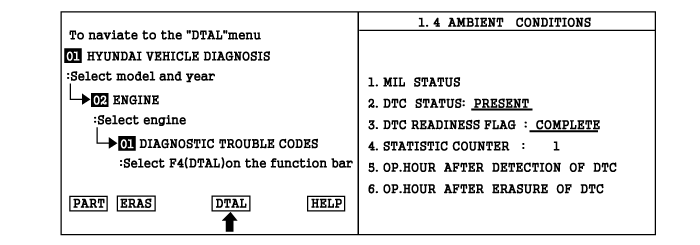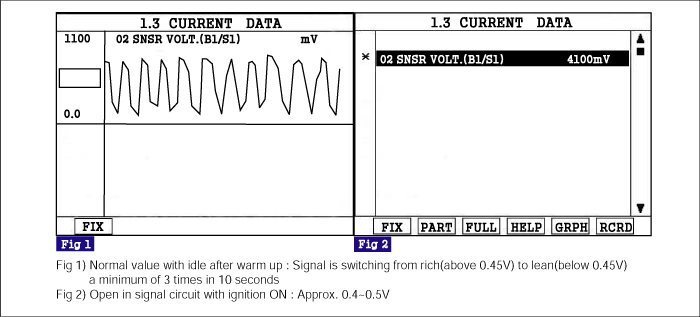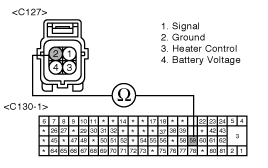Read "DTC Status" parameter.


The HO2S is used to supply the PCM with information regarding the composition of the air/fuel mixture. The HO2S is positioned in the exhaust pipe ahead of the TWC. To measure the oxygen content, the HO2S requires a supply of ambient air as a reference. Since this is supplied through the wiring, the lead must not be clamped or damaged in any other way. The HO2S produces a voltage that varies between 0.1V and 0.9V under normal operating conditions. The Engine Control Module (PCM) monitors this voltage and determines if the exhaust gas is lean or rich. If the voltage input at the PCM is under approx. 0.45V the exhaust is lean, and if the voltage input is over approx. 0.45V the exhaust is rich. The PCM constantly monitors the HO2S signal during closed loop operation and compensates for a rich or lean condition by decreasing or increasing injector pulse width as necessary.
PCM sets DTC P0130 if the PCM detects that the front HO2S signal circuit is open.
ITEM | DETECTING CONDITION | POSSIBL ECAUSE | |
DTC Strategy | ● Voltage range check | ● Open in signal harness. ● Open in ground harness. ● Contact resistance in connectors. ● Faulty Heated O2 Sensor(HO2S). | |
Enable Condition | ● Sensor preheating and full heating phases finished ● Modelled exhausr gas temp, > 600°C(1112°F) ● Lambda control active ● No relevant failure ● Battery voltage >10V | ||
Case1) | Threshold Value | ● Lambda control not active within the defined time | |
Case2) | ● 0,49V > Down HO2S > 0,37V and sensor element resistance > 60 KΩ | ||
Case1) | Diagnostic Time | ● 30~100 sec. depending on start temp. | |
Case2) | ● 10 sec. | ||


Connect scan tool and select "Diagnostic Trouble Codes(DTCs)" mode.
Press F4(DTAL) to select DTC information from the DTCs menu.
Confirm that "DTC Readiness Flag" indicates "Complete". If not, drive the vehicle within conditions noted in the freeze frame data or enable conditions.
Read "DTC Status" parameter.

Is parameter displayed "History(Not Present) fault"?
History (Not Present) fault : DTC occurred but has been cleared.
Present fault : DTC is occurring at present time.

▶ Fault is intermittent caused by poor contact in the sensor's and/or ECM's connector or was repaired and ECM memory was not cleared. Thoroughly check connectors for loose or poor connection, bending, corrosion, contamination, deterioration, or damage. Repair or replace as necessary and go to "Verification of Vehicle Repair" procedure.

▶ Go to next step as below.
Many malfunctions in the electrical system are caused by poor harness(es) and terminals. Faults can also be caused by interference from other electrical systems, and mechanical or chemical damage.
Thoroughly check connectors for looseness, poor connection, bending, corrosion, contamination, deterioration, or damage.
Has a problem been found?

▶ Repair as necessary and go to "Verification of Vehicle Repair" procedure.

▶ Go to "Ground Circuit Inspection" procedure.
Ignition "OFF".
Disconnect HO2S and PCM connectors.
Measure resistance between terminals 2 of the sensor harness connector and 59 of the PCM harness connector.
Specification : Approx. 0Ω

Is resistance within the specification?

▶ Go to "Signal circuit inspection" procedure.

▶ Repair open in the ground circuit and go to "Verification of Vehicle Repair" procedure.
Measure resistance between terminals 1 of the HO2S harness connector and 43 of the PCM harness connector.
Specification : Approx. 0Ω

Is resistance within the specification?

▶ Go to "Component Inspection" procedure.

▶ Repair open in the ground circuit and go to "Verification of Vehicle Repair" procedure.
Visually/physically inspect following items:
Inspect the front HO2S for any silicon contamination. This contamination will be indicated by a white powdery coating and this will result in a but false voltage signal.
If contamination is evident on the HO2S, replace contaminated sensor and go to next step.
Warm up the engine to normal operating temperature and check that HO2S signal is active.
Connect Scantool and monitor the "O2 SNSR VOLT. (B1/S1)" parameter on the Scantool data list.
Specification : Verify signal is switching from rich(above 0.45V) to lean(below 0.45V) a minimum of 3 times in 10 seconds (voltage will vary between 0.1 and 0.9V).
Is sensor switching properly?

▶ Check for poor connection between ECM and component: backed out terminal, improper mating, broken locks or poor terminal to wire connection. Repair as necessary and go to "Verification of Vehicle Repair" procedure.

▶ Check HO2S for contamination, deterioration, or damage. Substitute with a known-good HO2S and check for proper operation. If the problem is corrected, replace HO2S and then go to "Verification of Vehicle Repair" procedure.
After a repair, it is essential to verify that the fault has been corrected.
Connect scan tool and select "Diagnostic Trouble Codes(DTCs)" mode
Press F4(DTAL) and confirm that "DTC Readiness Flag" indicates "Complete". If not, drive the vehicle within conditions noted in the freeze frame data or enable conditions.
Read "DTC Status" parameter.
Is parameter displayed "History(Not Present) fault"?

▶ System performing to specification at this time. Clear the DTC

▶ Go to the applicable troubleshooting procedure.